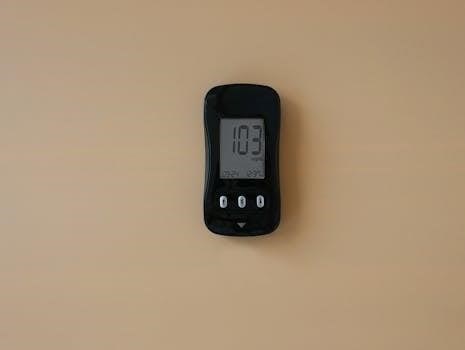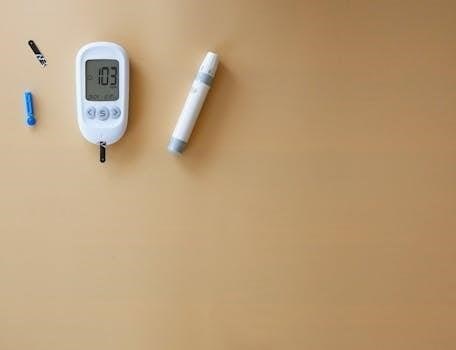What is a Manual Blood Pressure Cuff?
A manual blood pressure cuff, also known as a sphygmomanometer, is a device used to measure blood pressure. It consists of an inflatable cuff, a pressure gauge, and a stethoscope. It is a traditional tool, often considered the gold standard for accuracy.
Components of a Manual Blood Pressure Cuff
A manual blood pressure cuff comprises several key components working together for accurate measurement. Firstly, there’s the inflatable cuff, typically made of durable nylon, which wraps around the upper arm. This cuff contains an inflatable bladder that applies pressure to the artery. Next, we have the pressure gauge, often an aneroid dial, that displays the pressure applied by the cuff in millimeters of mercury (mmHg). This gauge is crucial for reading both systolic and diastolic pressures. A bulb is used to manually inflate the cuff, and a valve helps control deflation. Finally, a stethoscope is essential for listening to the Korotkoff sounds, which indicate the systolic and diastolic blood pressure readings. Each part contributes to the reliable operation of the device.

Why Choose a Manual Blood Pressure Cuff?
Manual cuffs are favored for their accuracy, particularly when properly used. They are also durable and do not rely on batteries, making them a reliable choice for many.
Accuracy of Manual Cuffs
Manual blood pressure cuffs, especially those using a mercury column (though less common now), are often considered the gold standard for accuracy. The accuracy of manual cuffs relies on the user’s skill in listening for Korotkoff sounds with a stethoscope, which can provide precise readings when performed correctly. While digital monitors use algorithms to estimate blood pressure, manual cuffs allow for direct observation of pressure changes, reducing the risk of errors from automated processing. This direct method can be beneficial for individuals who need precise measurements and want to avoid the potential inaccuracies of electronic devices. The reliability of a manual cuff, when operated by a trained professional, makes it a trusted tool in clinical settings. Additionally, manual cuffs aren’t subject to electronic malfunctions or battery issues, ensuring consistent performance. Therefore, the accuracy of a manual cuff, when employed with proper technique, is a primary reason for its continued use.
Durability and Longevity
Manual blood pressure cuffs are known for their robustness and long lifespan, often outlasting digital counterparts. Constructed with durable materials, such as high-quality nylon for the cuff, they are designed to withstand frequent use without easily breaking down. Unlike electronic devices, manual cuffs do not rely on complex circuitry or batteries, reducing the risk of malfunctions and increasing their longevity. The simple mechanics of manual cuffs mean that they are less prone to wear and tear and more likely to maintain accurate performance over time. This inherent durability makes them a cost-effective option, as they do not require frequent replacements. The absence of electronic components also means fewer parts that can fail, contributing to their overall reliability and extended lifespan. The sturdy nature of manual cuffs ensures they remain a dependable tool for many years, making them a practical investment for both healthcare professionals and home users who value longevity.

Key Features to Look For
When choosing a manual blood pressure cuff, consider the cuff size and fit for accuracy. An easy-to-read dial is also important, along with quality materials for durability, ensuring reliable, long-term use.
Cuff Size and Fit
Selecting the correct cuff size is crucial for accurate blood pressure readings with a manual cuff. An improperly sized cuff can lead to readings that are either falsely high or low, compromising the reliability of the measurement. The cuff should fit snugly around the upper arm, typically with the lower edge positioned about an inch above the elbow crease. Many manual cuffs come with a range of sizes or adjustable options to accommodate different arm circumferences, from small adults to larger individuals. A universal cuff design, like those in some models, may offer a versatile fit for multiple users. It’s important to ensure the cuff is neither too loose nor too tight to get a precise reading. Proper fit is paramount to obtaining useful information from your manual blood pressure cuff.
Easy-to-Read Dial
An easy-to-read dial is a key feature of a user-friendly manual blood pressure cuff. The dial should have clear, bold numbers and markings, enabling quick and accurate interpretation of the readings. A white dial with contrasting black numbers is often preferred for optimal visibility, especially in various lighting conditions. Some dials may also include color-coded zones to indicate different blood pressure ranges. The size of the dial should be large enough to see clearly without straining, and the needle should move smoothly for precise readings. A dial that is easy to read helps facilitate the process, ensuring accurate monitoring of blood pressure at home and in clinical settings. Look for dials designed for easy interpretation.
Quality of Materials
The quality of materials used in a manual blood pressure cuff is crucial for its durability and accurate performance. The cuff itself should be made of a durable, comfortable material like high-grade nylon that withstands frequent use without tearing or losing its shape. The inflation bulb should be constructed from robust rubber or latex that is resistant to cracks and leaks, ensuring consistent inflation. The tubing connecting the bulb and cuff must also be durable and flexible. The gauge should be constructed with quality metal and components. The use of superior materials ensures the longevity and reliability of the device, providing accurate blood pressure measurements over time. Look for a cuff with reinforced stitching and a durable gauge to ensure a long lifespan.

Top Rated Manual Blood Pressure Cuffs
Several manual blood pressure cuffs receive high ratings, including the PARAMED Aneroid Sphygmomanometer, Santamedical Adult Deluxe, and Scian Aneroid Sphygmomanometer. These are recognized for accuracy and reliability.
PARAMED Aneroid Sphygmomanometer
The PARAMED Aneroid Sphygmomanometer stands out as a top-rated manual blood pressure cuff, earning a 4.5-star rating with numerous positive reviews; This device is favored for its reliability and portability, making it suitable for both home and professional use. The kit includes a universal cuff, designed with extra durable nylon, that accommodates arm sizes from 8.75 to 16.5 inches. It features an easy-to-read dial gauge, which allows for precise blood pressure monitoring. The PARAMED also comes with a D-ring carrying case, enhancing its portability and ensuring it is protected when not in use. This manual cuff is considered a classic instrument, valued for its accuracy in measuring both systolic and diastolic pressures. Its robust construction ensures that it can withstand frequent use, making it a dependable choice for those who value accuracy and durability in their blood pressure monitoring equipment.
Santamedical Adult Deluxe Aneroid Sphygmomanometer
The Santamedical Adult Deluxe Aneroid Sphygmomanometer is another highly regarded option in the realm of manual blood pressure cuffs. This device is known for its quality construction and reliable performance, making it suitable for both personal and professional use. The Santamedical model is designed to provide accurate readings of both systolic and diastolic blood pressure, essential for monitoring health effectively. The cuff is made from durable materials, ensuring it can withstand the rigors of frequent use. One notable feature is its adjustable cuff size, which allows it to fit a wide range of arm circumferences. This ensures a proper fit, crucial for obtaining accurate measurements. Additionally, the clear and easy-to-read dial makes it simple to interpret the readings. The Santamedical Aneroid Sphygmomanometer is a popular choice for those seeking a dependable and user-friendly manual blood pressure monitoring solution, combining accuracy with ease of use.
Scian Aneroid Sphygmomanometer
The Scian Aneroid Sphygmomanometer is a manual blood pressure cuff designed for accurate and reliable blood pressure monitoring. This device stands out for its user-friendly design, incorporating a D-ring universal cuff that accommodates various arm sizes. The adjustable cuff ensures a secure and comfortable fit, which is essential for obtaining precise readings. The Scian model features an easy-to-read dial, allowing for quick and straightforward interpretation of results. Its construction emphasizes durability, utilizing high-quality materials designed to withstand frequent use. It is a practical choice for both home and professional settings. This sphygmomanometer is often sold with a convenient carrying bag, making it portable and easy to store. While it doesn’t include a stethoscope, the Scian Aneroid Sphygmomanometer is a valuable tool for anyone needing dependable manual blood pressure measurements. It is valued for its combination of accuracy, durability, and ease of use.
How to Use a Manual Blood Pressure Cuff
Using a manual blood pressure cuff requires proper technique for accurate readings. It involves correctly placing the cuff, inflating it, and using a stethoscope to listen for sounds to determine blood pressure.
Proper Technique for Measurement
To ensure accurate readings with a manual blood pressure cuff, start by positioning the cuff correctly on the upper arm, typically about an inch above the elbow. The arm should be supported at heart level. Place the stethoscope’s diaphragm over the brachial artery, just below the cuff’s edge. Inflate the cuff until the pulse disappears, then slowly release the air while listening through the stethoscope. Note the systolic pressure (the first sound) and the diastolic pressure (when the sound disappears). It is important to have a quiet environment and avoid any movement during the process. Consistent technique helps maintain reliable results for monitoring your blood pressure.

Maintenance and Care
To maintain accuracy, store the cuff properly, avoiding extreme temperatures. Regularly check for leaks or damage. Clean the cuff with a mild disinfectant. Proper storage and care ensures longevity.
Ensuring Accuracy Over Time
Maintaining the accuracy of a manual blood pressure cuff is crucial for reliable readings. Regularly inspect the cuff for any signs of wear and tear, such as cracks or leaks, which can compromise its performance. The inflation bulb and valve should be checked to ensure they are functioning correctly, allowing for smooth inflation and deflation. The pressure gauge, or manometer, should be calibrated periodically against a known standard, if possible, to ensure it is displaying accurate pressure readings. Additionally, proper storage is important; avoid exposing the cuff to extreme temperatures or direct sunlight, as this can affect the materials and its calibration. Cleaning the cuff with a mild disinfectant according to the manufacturer’s instructions will also help prevent the build-up of contaminants and maintain its integrity. These practices will help to ensure consistent and accurate blood pressure monitoring over time.




